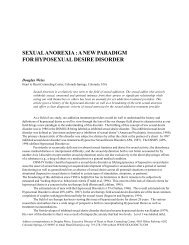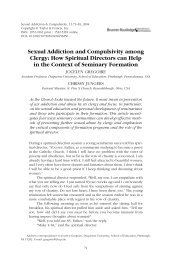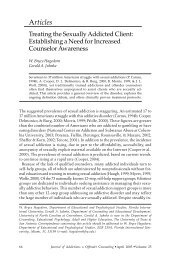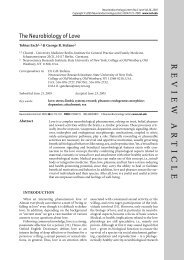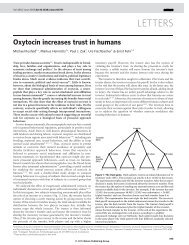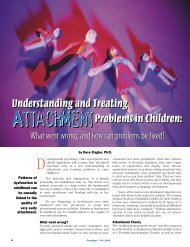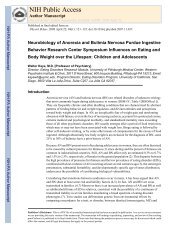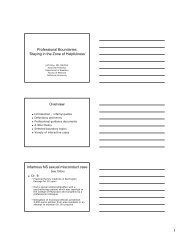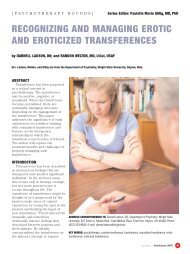HEALTHY SEXUALITY: STAGE I11 RECOVERY
HEALTHY SEXUALITY: STAGE I11 RECOVERY
HEALTHY SEXUALITY: STAGE I11 RECOVERY
You also want an ePaper? Increase the reach of your titles
YUMPU automatically turns print PDFs into web optimized ePapers that Google loves.
Sexual Addiction & Cornpulsivity5 Dimensions of Sexual HealthFigure 2. Manley Sexual Health ModelTo illustrate this figurativeiy, the stages can be portrayed as those of athree-layer globe (see Figure 3). When this globe is bisected, it reveals thatthe five dimensions of healthy sexuality are present in all three stages. Forexample, as the person recovers in all five dimensions from the unhealthylifestyles and inappropriate coping mechanism of the victimladdict layer,recovery then becomes necessary in all five dimensions at the stage of underlyingwounds. Healing of this wounded survivor stage allows for breakageof the trauma bonds which have led to relapse.opera.7simila
Healthy Sexualitystop acting:ave a wake+whether~aking intoin the form:d. At each;resses withto build aI to identifynning. An-Iimensions.: 1.:h recoverybehaviors,~g that anynce as longhe primaryor couplea programI1 forms ofN weeks, alifetime ofs of volunandfourth: should beThe person, emotionaldispositionsease. The~g sex anded and ad-:ontrollingI up to the>I the pain.Mark all that apply.Staae I Recovey:Staae I1 Recoverv:Staae Ill Recovery:Figure 4. Manley Staging QuestionnaireI have 0-18 months of recovery from my addiction(s), including thecompulsive sexual behaviors of myself or someone significant to me.I am working a Twelve-Step program and am getting clarity about the waysthe addictive cycle works in my life.I have a sponsor with whom I am regularly in touch.I have a working definition of sobriety, and I am progressing through longerperiods of sobriety between slips.I am beginning to remember ways I was sexually wounded.I sometimes have flashbacks or body memories about my trauma when Ihave a sexual experience today.I am in therapy and actively working through the feelings that are a result ofmy trauma.I can remember my trauma and the feelings that go with it and do notusually get stuck in those feelings.I feel good about myself as a sexual human being.I am able to choose to commit myself to a partnered relationship, even if Iam not in one now.I enjoy a variety of sexual activities within my boundaries.I can function sexually within my physical capabilities, i.e., have andmaintain erections, experience vaginal engorgement and wetness, getaroused, experience orgasms when I want to do so.My sexual experiences are in line with my sexual belief system.If your answers cluster in one group you probably are in that stage. If they are in two ormore groups you are probably moving through the journey towards sexual thriving.
Healthy Sexualityitage Ill:~al Thrivinginnocent anddeserving ofnconditionally.'capable ofa loving, mu-!lationship withier to whom Inmitted.'enjoy genitaling with myI have diffinaintainingmyn I can tell myr about myof loss of mysod and we can,gether to helpgain my erec-exual connec-; a source ofmeaning in myre apparenti a relationnentof theI be able to:to "friendsFigure 5. Manley Sexual Health Recovery Model\ ' survivorAddic flit timof the recovery," such as the members of a twelve-step fellowship. Thisteaches the person how to eventually attach to a significant other in a positivemanner.The tasks of Stage I recovery, well defined by Carnes (1983,1989,1991)and others (Manley, 1990), include: 1) limit excessive sexual behaviors; 2)detach from entangled relationships; 3) seek a spiritual connection; and 4)develop friendships with safe other recovering persons.Stage IIAs the "medicating" addictions are removed, the outer layer of themetaphorical globe "thins" (see Figure 6), and the second layer is moreapparent, or "thicker." The second stage of recovery, described by Schwartz
Sexual Addiction 4 Compulsivity\ \ SurvivorFigure 6. Manley Sexual Health Recovery Model(1991), involves recovery from underlying wounds. The wounds in this layerare very tender and, in the absence of medicating behaviors, need a lotof protection.The work at this level is aimed first at creating safety through redefiningboundaries in certain relationships, such as with an abusive parent, sibling,or other offender, and through providing a structure for "normalizing" theemergence of memories and feelings. Additionally, the facilitation of workingthrough these painful feelings and the integration of this trauma in the person'sbackground help to complete the healing at this level. As this healingprocess continues, clients often visit and experience their wounded "innerchild" (the there-and-then) and develop a caring, nurturing "inner adult"who can be present in the here-and-now.Successful resolution of second-level healing allows the person to developand use appropriate coping mechanisms for managing inner pain,rather Ihealingglobe 'sexualiMof wouadditioextremof healpcrsitiv~St;trauma
Healthy Sexuality.Thriving' Survivoric t/Victimin this layer, need a lot;h redefining.ent, sibling,lalizing" the1 of working3 in the perthishealingnded "innernner adult":rson to deinnerpain,Figure 7. Manley Sexual Health Recovery Model\ \ survivor' ~ddic t/~ic tirnrather than the inappropriate ones of first-level addiction. When second-levelhealing has occurred, this formerly "thick" layer of the bisected metaphoricalglobe "thins" and allows for the emergence of the third stage-the thrivingsexuality stage (see Figure 7).Most discussions of sexual wound healing have focused on the healingof wounds inflicted by others on one's individual self, usually in the past. Inaddition to this healing, for recovering persons who are in coupleship, it isextremely important to heal the wounds in the relationship, so that the toolsof healthy detachment, so important in Stages I and 11, can be replaced bypositive attachment in Stage 111.Stage I1 requires even more care for detachmentlattachment as thetrauma bonds of negative attachments are broken and tentative steps towardpositive attachment are made. In general, the wounded survivor is fragile
1 70 Sexual Addiction & Compulsivityand often confuses, frequently at an unconscious level, a here-and-now relationshipwith a there-and-then relationship.The tasks of Stage I1 for the individual include: 1) continuing to refrainfrom excessive sexual activities; 2) creating safety to allow emergence ofmemories and feelings; and 3) working within a structure and with professionalguidance to remember, revisit, and integrate past wounds to oneself.The tasks in Stage I1 for a couple include: I) both persons use positivecoping mechanisms for pain and anger; 2) separate conceptually the partsthat woundedlwere wounded from the present selves; 3) refrain from priorbehaviors; 4) name wounds as specifically as possible; 5) acknowledge ownresponsibility as one who inflicted the wounds; 6) acknowledge own responsibilityas one who received wounds; 7) apologize sincerely and with remorse;8) accept apology and let go of the wound (integration); and 9) see selvestoday as separate from previous selves, that is, as a capable adult of todaywho has voice and has tools rather than as an overpoweringlpowerless personof before who was out of controllwho had no control.Stage IZI: Recovery of Healthy SexualityThe focus of work in Stage I is the present-elimination of destructivepatterns in the here-and-now. The focus of work in Stage I1 is the past-healingof the wounds of the there-and-then. The focus of Stage 111, sexual healthrecovery, is forward. It requires recovering persons to consider going wherethey have never been before-to a new frontier of healthy, positive, thrivingsexuality.ThctoStUlselfancaricneeTh(erirParple;Parin csucthrtsex.aboPOSThe tasks for persons in third-stage recovery are:1. Continued effective limitation of unhealthy sexual activities.2. Continued integration of past sexual wounding.3. Emergence of adult self capable of making positive choices.4. Very slow, gradual attachment to both adult sexual self and to significant-otherrelationship.5. Clear demarcation of boundaries for physical touch.6. Communication training on recognizing and giving voice to sexual needsand desires.7. Education on sexual physical function of both partners.8. Expansion of sexual repertoire within boundaries.9. Practice with emotional and physical intimacy.10. Practice with sexual etiquette (good manners).11. Developent of sexual mentorsladvisory committee.12. Participate in sex therapy.
Healthy Sexuality 171nd-now rela-ng to refrainmergence ofwith profes-Is to oneself.use positivelly the partsn from prior~wledge ownown responrithremorse;9) see selveslult of todaybwerless per-f destructive: past-healexualhealthgoing wheresitive, thriv-These tasks include continuing to use the tools from the previous two stagesto remain sober and to heal from the wounds. As the wounded and/orstunted child part of the self recedes into the background, the emerging adultself begins to experience the capability to make positive choices about selfand attachments. This emerging adult can take risks within personal boundariesand can gradually learn to recognize and give voice to personal sexualneeds and desires derived from the secure, rather than wounded, sexual self.The adult self can also hear the needs and desires of another.Feeling safer about self and more aware of personal feelings, the recoveringperson in Stage <strong>I11</strong> can share more passion and can receive that of apartner. The person learns how to use basic sexual manners-such as "Yes,please," "No, thank you," and "May I?"-that can be reciprocated by apartner.Most important of all at Stage 111 is the inclusion of other sexual thriversin one's support network. For many recovering persons, this may be difficult.Such persons are only beginning to be generally available. It usually takesthree to five years from the time of starting recovery to the beginning ofsexual thriving. Along the way, one often hears many negative messagesabout sexuality. The thriver "role models" are important reminders of thepositive aspects of sexuality.SpeciJic Considerations for Stage III TherapyThe therapist of the recovering person at Stage <strong>I11</strong> also has a numberof tasks. These are:id to signifi-sexual needs1. Become very informed about the work at Stages I and 11.2. Respect all boundaries set in previous stages.3. Recognize that the person/couple will have remissions into either previousstage, and be prepared to do relapse treatment.4. Go very slowly.5. Help fashion a coupleship vision of where they want to be sexually inall five parts, not just their sexual behavior.6. Facilitate agreements around the role of touch.7. Reinforce trust-building experiences.8. Assess for sexual dysfunctions and intervene as needed.9. Prescribe bibliotherapy-books, articles, and audio- and videotapes-tointroduce healthy sexual knowledge and role models.10. Continue to see individuals/couples regularly after they begin to growin this stage.
1 72 Sexual Addiction & Cornpulsivity11. Facilitate open discussions about sexuality.12. Encourage attendance of the adult selves at safe adult sexuality seminarsor workshops.One of the challenges for therapists seeking to guide recovering personstoward a thriving sexuality is that often a substance abuse counselor is theprimary helper in Stage I and a trauma resolution therapist helps with Stage11. Stage 111 has been left to various other helpers, most commonly the sextherapist. The problem with this approach is that many sex therapists donot have the complete picture of how Stage I and Stage I1 must be treatedbefore thriving sexuality can be implemented.ReadinessAn understanding of "readiness" is crucial for bridging into Stage 111healing. Just as one would not expect three- or four- or nine-year-olds, andprobably not 12- or 15-year-olds, to be ready to voluntarily journey intoforeign, unmapped territory, one would not expect a person who is chronologicallyadult, but emotionally young, to be ready for this journey.I am reminded of a recent incident with a client. "Bob," who is in his30s, has been my client for many years. Bob first contacted me when he wasunable to stop his voyeurism and was risking arrest as he became morepowerless in his behaviors. At the time, he was dating "Mary," his girlfriendfor two years, and was considering getting engaged to her. In addition tohis acting-out behaviors, he was extremely rigid about sexuality in general.I initially sent him to Sexaholics Anonymous. He connected to the programquickly and has been technically sober and in recovery since that time.At about that same time, I attempted to introduce sex education andthereby increase his sexual flexibility. I suggested to him a college-level textbookon sexuality. He took it with him out of a sense of obligation (afterall, I was the authority), but soon returned it unread in a manila envelope,saying he felt too afraid to read it. Over the course of these last seven years,he completed residential therapy for sex addiction, married Mary, completedresidential therapy for codependency, entered and completed graduateschool, and engaged in very sporadic, unsatisfying lovemaking with Mary.Periodically they would see me as a couple, and I would suggest more readingor guided touching experiences or couples' intensives, but Bob would rejectthese. About a year ago, they decided that they wanted to have a baby, butsince they rarely had intercourse, the chances of conception were unlikely.Whenever Bob considered making love with Mary, he would hear voicesinside his head saying, "The sexy lady will kill you" or "The monsters willchop you up," and he would avoid any sexual contact. He also became moreand morthis back .with the IBy tlwhich soI asked tlthey coulcould drz"experimduced a sby his mcother ad1human szBobwere macIn that sehow his :develop,"kids," bin his lifeto ackno~is beginnbought scthe "kidsdo sevenfor it becProtectiiThethoroughclose seccdone, espIt is :the perso(Prochaskrecognizi~The wisea coupleparts, notIt wiltouch anc
Healthy Sexuality 1 73~lity seminars:ring personsunselor is theps with Stagenonly the sextherapists do1st be treatedinto Stage <strong>I11</strong>ear-olds, andjourney intoho is chrono-Irney.who is in hiswhen he was~ecame morehis girlfriendn addition toty in general.the programhat time.ducation and:ge-level textigation(afterlila envelope,t seven years,ry, completedted graduateg with Mary.more readingwould rejecte a baby, but
Sexual Addiction & CompulsivityFigure 8. "Drawing the Line" Boundary ExerciseAdapted from Maltz & Holman (1987) Appendix CTalking - Letter writingOn telephone or computerIn personParticipating in group activitiesBecoming friendsDating - Double datingSingle datingHolding handsPuttingtreceiving arm across shoulderTouching shoulders, knees, and so forthSpending time together in nonsexual activitiesHand caressHugging - "A frame" hugFull body hugDancing - FastSlowKissing - Peck on the cheekDry mouth kissingWet mouth kissingFrench kissingDeep soul kissingPetting - With clothes onWith some clothes offWith all clothes offEngaging in genital stimulationEngaging in intercoursePlease draw a solid line under the &t listed behavior with which you feel completely safe.Draw a dotted line under the last behavior with which you feel somewhat safe. You mayrearrange the order in any way to suit your own hierarchy. In general, at first your touchboundaries need to stay above the solid line. Those behaviors below the solid line and abovethe dotted line are open to discussion as you gain trust. Eventually you may choose to moveeither line to reflect your comfort. With couples, the person whose solid line is highest on thelist chooses to establish the couple boundary at hislher level as a beginning.to experience safe and loving touch. To help concretize this safe, progressivetouch, I ask patients to use the "Drawing the Line" boundary exercise (seeFigure 8).Because individuals who are recovering from sexual addiction and sexualtrauma frequently experience classic sexual dysfunctions, such as erectiledysfuncticas neededlems, howboundarieSexu:apy-boo:ual know1the mater:the othersexual selfIt has bee]of accepti:of the 0thPeopland knowhealthy seindividualfound intcThe purporestructuriRegarmeditatioring new teing My Se:during thea workshestep invengoals theytheir resotences-ancFinal1person forsexual act:Meditsexual recc
Healthy Sexuality 175dysfunction and orgasmic difficulties, the therapist will assess and interveneas needed. Many of the standard sex therapy interventions for such problems,however, do not take into consideration the previously mentionedboundaries.Sexual therapy at Stage <strong>I11</strong> often includes the prescription of bibliotherapy-books,articles, and audio- and videotapes-to introduce healthy sexualknowledge and role models. The therapist should be very familiar withthe materials, so that they do not unnecessarily threaten a boundary. Onthe other hand, the therapist will need to encourage the emerging adultsexual self to take responsibility for limiting and/or accepting specific media.It has been my experience that persons at this stage are very often capableof accepting explicit media which would have been unacceptable at eitherof the other two stages.ASK GUIDANCE AREASPeople in Stage <strong>I11</strong> recovery need guidance in three areas: attitudes, skills,and knowledge (ASK). The guidance can include reading a general book onhealthy sexuality, attending a lecture on sexual health, specific couple orindividual therapy, and intensive or experiential processes that foster profoundinternal growth and healing in a safe and structured environment.The purpose of any level of work is for cognitive, emotional, and behavioralrestructuring.completely safe.safe. You mayt first your touchlid line and abover choose to moveis highest on thefe, progressivey exercise (see.ction and sex-;uch as erectileAttitudesRegardless of how intensely a person may be working, I strongly urgemeditation and self-reflection as means of recording progress and of exploringnew territory. Just as all explorers have kept journals, I suggest a "HealingMy Sexuality" journal and ask that clients record everything that occursduring the journey-whether it makes sense or not at the time. I give thema worksheet for sexual health recovery, which involves an abbreviated firststepinventory of ways they were powerless over their sexual shame andgoals they would like to accomplish as they proceed. I ask them to inventorytheir resources-previous education, workshops, and any positive experiences-andto select those which will be useful or essential on this journey.Finally, the worksheet directs them to contract with at least one otherperson for success with the plan. This helps break the pattern of secretivesexual acts and increases the likelihood of accountability.Meditation and reflection help to facilitate the first of three elements ofsexual recovery: attitude change. Since virtually all sex addicts and co-sex
1 76 Sexual Addiction & Compulsivityaddicts are survivors of sexual shame, and unhealthy beliefs about sexualityare deeply ingrained, this step is one of the hardest to begin. In the simplestof understandings, for the survivor all sex equals sexual abuse, so a fundamentalshift in attitude is from viewing sex as "dirty, bad, and harmful" toviewing sex as "enriching, positive, and enjoyable."To accomplish this, I suggest that a person initially adopt one, or atmost two, different, more healthy beliefs to replace unhealthy beliefs. Rememberingthe five parts of sexual health, I try to direct attitude changewithin each different area. Some examples of these positive attitudes or affirmationsare:1. I am a sexual being, separate from my sexual doing.2. I can ask for and refuse sexual gratification.3. Sex is a source of goodness in my life.4. I am willing to commit to a primary relationship.5. I can have sexual moments that are very meaningful.In addition to repeating a statement, I suggest that the person write a briefparagraph about the phrase-similar to a page in a daily meditationguidebook.I often suggest that people write out a sexual "declaration of independence"and follow this with a "bill of sexual rights," from which evolvemore positive affirmations. If they reject the possibility of these affirmationsever feeling "rea1,"I suggest they "act as if" or "fake it till you make itMandcontinue to repeat them several times a day. Eventually they will cross overfrom the head to the heart.Because the negative sexual programming is so deep-seated, I use repetitionand flooding to counteract the negatives. I have them write a healingscript and use it to make a nurturing, affirming audiotape to play severaltimes a day. This technique is especially effective for inner child work; theparent part "teaches" the kids with new messages. I teach them to counteractnegative programming by reorganizing it and reinterpreting information.Attitude exploration and development are well suited to group workwhere individuals can receive feedback and support in a safe setting. In thelast couple of years, I have been encouraging some clients with solid addictiverecovery and a well-enough-developed sense of self, who can make arrangementsfor their young inner parts to be cared for someplace else, to participatein our SAR weekend.SAR, Sexual Attitude Reassessment (or Restructuring), is an intenseadult sexuality education experience in a structured setting using large grouplectures and sexually explicit audiovisual media presentations and smallgroup pro8new ones.experiencetent staff;SkillsLearnsurvivors Isensuousncbilities.Stagereceive nu.extremelytouching rsexual objlstep on to1cerning 'to.to specificSex tksensate foca more gelI1 clients, Itouching enever do tlI and I1 c:either retrinstructiorpresent toWencintroduce(in Stage I1very smallanother szsurvivor bwhile inccAm01caress insmall, genany talkining and reerful wher
Healthy Sexuality 177about sexuality, In the simplestJse, so a funda-~nd harmful" todopt one, or atthy beliefs. Reattitudechangeattitudes or af-on write a briefaily meditation:ion of indepennwhich evolveese affirmationsou make itwandr will cross overted, I use repetiwritea healingto play severalchild work; them to counteractinformation.to group worke setting. In the!I solid addictiveI make arrangeelse,to partici-), is an intenseiing large groupions and smallIgroup process to challenge old attitudes and encourage the development ofnew ones. There are several crucial elements to SAR's being a successful3experience for a Stage 111 person: I) emotional readiness; 2) sensitive, compeitent staff; and 3) community with others.IiiLSkillsfLearning skills is the second part of change. Recovering addicts andsurvivors need a great deal of help with skills, including self-nurturance,1sensuousness, conversational skills, courtship abilities, and lovemaking capa-Iibilities.Stage 111 skills training involves, among other parts, learning to give andreceive nurturing touch. The role of touch to the recovering sex addict isextremely important, since most recovering people have never had a positive1touching relationship, and many have only experienced touch in time ofsexual objectifying. Therefore, it is important to start out with doing a first5 step on touch. In addition, it is important to clearly define boundaries con-?! cerning touch and to work in a progressive and slow process from generalto specific sexual touch.Sex therapists have worked with "sensate focus" for years. Essentially,fsensate focus is focused touch, proceeding from general, peripheral touch toa more genital, sexual touch. In my early days of working with Stage I andI1 clients, I used to wonder why sensate focus did not work. I would prescribe!touching exercises, often invoking a ban on intercourse, and people wouldInever do their cchomework." What I understand now is that people at Stages6:I and 11 cannot possibly succeed with sensate focus, because it represents! either retraumatization or perpetration. They would always sabotage myinstructions in order to survive. Only Stage <strong>I11</strong> journeyers have enough selfi present to safely risk sensate focus.fWendy Maltz (1991), in her excellent book The Sexual Healinglourney,introduced me to the notion of "pre-sensate focus," in which the survivoriin Stage I1 recovery gradually gains mastery over touch through a series of1very small exerclses practiced with a partner in the safety of one's chair oranother safe location. With each success, trust develops, and eventually thesurvivor bridges into Stage <strong>I11</strong> by risking to be totally present and accountablewhile incorporating focused sexual caressing in the lovemaking experience.Among the lessons I teach Stage <strong>I11</strong> persons is to give and receive a handcaress in which I guide a couple to make love to each other's hand, usingsmall, gentle, loving caresses and conveying love and caring without usingany talking or other communication. The concept of "making love to"-giv-I ing and receiving love-rather than screwing or getting screwed is very POW-1 erful when experienced in a hand caress. I often have couples tape the session
1 78 Sexual Addiction & Compulsivityand use the tape as a guide in practice sessions at home. Eventually we usethe same technique to bridge into foot, head, face, general body, and specificsexual body parts. Many clients have observed that this experience has providedthe first opportunity for them to feel safe enough to receive touch fromanother individual-and at the same time be connected to their bodies andto their spirit.When an individual or couple begins to show growth in this stage, it isextremely important to continue to see the person or couple on a regularbasis to help reinforce that growth. Open discussions about sexuality, includingall five parts of the Manley Model, should be facilitated and encouraged.In addition, the therapist can encourage attendance of the emerging adultsexual selves at safe adult sexuality seminars or workshops.As therapists begin to help people move into a more genital focus, it isimportant to know what the sexual acting-out experiences have been andto help the couple develop boundaries around experiences that have beensexually abusive andlor exploitive. For example, if the primary sexual actingoutbehavior has been anal teasing or anal penetration, it is important toset a boundary around that kind of genital experience and to encourage thecouple to use only vaginal penetration. It is also often very important forthe co-sex addict to be the person who decides when and what the coupleexperiences in a genital way, because the sex addict may not be able toseparate his or her addictive part from the healthy part when directly involvedin a sexual experience.The therapist will need to work with the recovering person or coupleto define both positive and negative boundaries around a variety of otheractivities. That is, if the use of candlelight and music was a part of theaddictive behaviors, it should probably not be a part of the positive sexualexperience. On the other hand, if all the sexual experiences occurred in thedark without any romantic context, perhaps romance can be added as a partof the positive sexual experience.I use commercial sex education videotapes of couples (actors, practicingthese skills) as role models. I always mention that the tapes include nudity,and that it is the couple's responsibility to protect their boundaries by decidingwhat to watch. In my experience, no one has been triggered to act outby the use of these explicit media.Two other skills involve exploring the possibility of healthy masturbationand healthy fantasy. Many sexual addicts find it difficult to masturbatein a "healthy way." Masturbation for them is the ticket back into the addictionand becomes like the first drink for the recovering alcoholic. This isparticularly true if the sexual addict has experienced masturbatory sexualabuse as a child or has been masturbatorily self-abusive as an adult. Somesex addictsand to devence healtlGuidelines1. The per2. The perthe expc3. The perperson;4. If the pipart of5. The peror her sIt is indefine bouaddicts ha$to conceivtto report tHowever, imasturbatiFor mlimits forefantasy be!can be encages. For eother femaencourage(to her at telse's facea way of irpractice arthe develolimagery. Aa commercdevelop ascripts ancpositive serience.
Healthy Sexuality 1 79ventually we useody, and specific)erience has proceivetouch fromtheir bodies andn this stage, it isple on a regulariexuality, includandencouraged.: emerging adultznital focus, it iss have been andi that have beenry sexual actingisimportant to:o encourage the.y important forwhat the couplenot be able to{hen directly in-kerson or couplevariety of other1s a part of the: positive sexualoccurred in the: added as a partctors, practicinginclude nudity,.daries by decidgeredto act outalthy masturba-It to masturbate: into the addiccoholic.This isarbatory sexualan adult. Somesex addicts, however, who are able to successfully recover their sexual personand to develop that sexual person into a well-functioning adult, can experiencehealthy masturbation, as opposed to a demeaning sexual experience.Guidelines for healthy masturbation include:1. The person masturbates without the use of any sexual toys.2. The person is connected to himself or herself and the environment duringthe experience.3. The person can share the experience before and afterward with anotherperson; thus, it is not a secret activity.4. If the person is in a committed relationship, the other person can be apart of the experience.5. The person experiences connection with himself or herself and with hisor her spiritual core after the masturbatory experience.It is important for therapists to work with recovering persons to helpdefine boundaries concerning healthy masturbation. Most recovering sexaddicts have never had an experience of it, and it is very frightening to beginto conceive of such an idea. If one has a healthy experience, it is importantto report that and to talk about the possibilities of its being an option.However, it is not the only option, and the person needs to be able to choosemasturbation rather than using it to medicate feelings.For most recovering sex addicts, use of pornography is probably offlimitsforever because of the issue of addictive fantasy and the way thatfantasy begins the ritual of addiction. On the other hand, healthy fantasycan be encouraged in terms of creating and developing positive sexual images.For example, a heterosexual man who has constantly fantasized aboutother female partners during the sexual experience with his spouse might beencouraged to daydream about his spouse, use her name, and feel connectedto her at the moment-as opposed to objectifying her or putting someoneelse's face on her. For sex therapists who have used fantasy prescriptions asa way of increasing a person's sexual arousal, it is important to modify thatpractice and to work within the person's recovery boundaries to encouragethe development of healthy sexual visioning. It may be useful to use guidedimagery. A taped sexual guided image may be prepared by the therapist, ora commercially available one may be used as a way of helping the persondevelop a positive sexual fantasy. Even better, clients can write their ownscripts and make their own tapes. For many people who have never had apositive sexual fantasy, being directed to have one can be a powerful experience.
Sexual Addiction 4 CompulsivityKnowledgeKnowledge is the third part of change and empowerment. Few of usgrow into adulthood with enough sexual knowledge to empower us as sexualadults. Some of us remain perpetually "stuck" in our wounded emotionalchildhood, and looking through keyholes or visiting strip bars is, in someway, a quest to find some of the answers that we needed earlier in life.Age-appropriate sex education is enormously important. Just becausea person has had 2,000 sexual experiences does not mean that he or she isknowledgeable about sex. In fact, in my experience, many sex addicts arejust as sexually ignorant as the rest of the population. As I work with Stage111 clients, I constantly keep in mind the question, "Who is here?" Sexualityeducation feels to the wounded survivor part and the victim part like beingreabused. Therefore, it is very important to have enough of an adult presentto help the kid parts to learn to trust that sexuality knowledge is not abusiveand that they can be safe and learn at the same time.The story of Bob, which I told earlier, is especially illustrative of theimportance of knowing "who is here" regarding sex education. Thankfully,there are now wonderful sexuality books for kids of all ages, so a personcan go to a bookstore and request something appropriate for a three-yearoldor a six-year-old or a 12-year-old and meet the needs of that inner child.I teach people to take inventory of "who's here"-borrowing from workwith multiple personality disorder-and to take care that if one is learning"adult stuff" the "little kids" be somewhere else.Recently on a radio call-in show, I was challenged about my statement:"Sex knowledge is empowering, and one of the major tasks of a healthyfamily is to empower the children." The caller said that giving children sexeducation will just send them running to have sex. In fact, nothing is fartherfrom the truth. I believe that withholding sexuality education is negligent -and a form of sexual abuse. To try to illustrate my point, I told about anencounter experienced by a parent at a family reunion a few years ago.Josh, who was 11, was being teased by his 16- and 18-year-old malecousins, who were calling him "Buster." He was grateful for the attentionand wanted to join in their laughter, but he realized that he was being pickedon. It was a rainy day, and they were all sprawled on the living room flooras the parent walked through. Just as she got to the other side, Josh calledout, "Mom, what's a hymen?" The room went silent and the older boyslooked on the verge of death. She turned and explained to him that a hymenwas a piece of skin that was attached to the opening of the vagina, and thenshe asked him why he wanted to know. "Darren and Rob have been callingme 'Buster Hymen' and I don't know whether that's good or bad," he said. 'The powcjoke hadnot heardReco.paraphrascation."I oft€openly anarea likefirst expesexual oriing one's"I've bee1women, twoman awhen I wAnotat sexualare funn!marked,been thrcTheAfter anestrangecas he railThroughto close 2tionablyAnothat befchim thatand at t!departedI am chohaving tc
Healthy Sexuality 181ment. Few of us3wer US as sexuallnded emotionalbars is, in some:arlier in life.int. Just becausethat he or she isi. sex addicts arework with Stagehere?" Sexualityn part like being' an adult presentIge is not abusivellustrative of thetion. Thankfully,tges, so a personfor a three-yearfthat inner child.wing from workif one is learningIU~ my statement:tsks of a healthyving children sexnothing is fartheration is negligent, I told about an:w years ago.18-year-old malefor the attentionwas being pickedliving room floorside, Josh calledd the older boys~im that a hymenvagina, and thenhave been callingor bad," he said.The power they had over him was gone. He had broken the silence. Thejoke had no impact any more. He had his power back, and "Buster" wasnot heard for the rest of the reunion.Recovering people get their power back when they have knowledge. Toparaphrase a recovery clichk, "It's never too late to get a healthy sex education."SIGNS OF HEALINGI often know that healing is taking place when I hear people sharingopenly and honestly-asking one another, "What is this particular sexualarea like for you?" For many Stage <strong>I11</strong> recovering people, this may be thefirst experience of asking someone of the opposite gender or of anothersexual orientation or ethnic culture about that person's experience and sharingone's own. I am reminded of a man of about age 50, who recently said,"I've been an addict for years and have had lots of sexual experiences withwomen, but I've never really looked at a woman and I've never talked to awoman about sex. This experience has helped me get information I neededwhen I was 12 or 14."Another way I observe healing in the thriving stage is to hear laughterat sexual humor. Not laughter at someone's expense, but just because thereare funny sex stories, jokes, and situations. A woman at third stage remarked,"It feels so good to be able to laugh about sex after all that I'vebeen through."The deepest level of healing in third stage is the sexual spiritual healing.After an intensive workshop session, a man tearfully said that he had feltestranged from God for years, initially because of his acting-out and lateras he railed at the god who failed to protect him from his childhood abuse.Through the work he'd done in the intensive session, he felt that cleft beginto close and could feel God's love inside him and believe that God unquestionablycherished the man's sexuality.Another man, who had been in a celibate vocation for years, remarkedthat before he came to the intensive session, some of his brothers had toldhim that they doubted that he could experience an explicit sexual workshopand at the same time return to the monastery. Chuckling just before hedeparted for home, he said, "They'll never believe that after this experienceI am choosing to remain celibate as a celebration of my sexuality rather thanhaving to be celibate to try to contain my sexuality."
Sexual Addiction 4 CompulsivityCONCLUSIONSexual therapy for recovering sexually addicted persons and couples isan emerging field for therapists. Guidelines for working with recoveringpersons are just being developed, and they are based on guidelines alreadydeveloped for working with sexual trauma survivors. Like the model forworking with sexual survivors, the model for working with sexual addictsincludes a primary step of stopping the compulsive and addictive sexualbehaviors and then working toward recovery through the 12-step fellowshipand organized treatment programs. The therapist needs to help the individualor couple recover a sense of sexual personhood and then to connect inhealthier ways in a variety of different relationships and roles. As the abilityto experience feelings of sexual responsiveness returns, the therapist shouldwork within the boundaries of the recovering person or couple to enhancethe sexual experiences.Finally, the therapist should continue to promote the spiritual healingby supporting the 12-step fellowship and encouraging the person or coupleto evaluate and modify the sexual attitudes and beliefs in ways that encouragea positive grace-based sexuality, as opposed to negative shame-based sexuality.The therapist who chooses to work with this group of clients will findthe work difficult and fraught with frustration. But it will be ultimatelysatisfying as the person or couple moves from negative sexual experience topositive sexual experience that is a matter of choice, not driven by addiction.Prochaska, J.change:1102-11Schwartz, £3.state discConselorREFERENCESCarnes, P. (1983). Out of the shadows: Understanding sexual addiction. Minneapolis:CompCare.Carnes, P. (1989). Contrary to love. Minneapolis: CompCare.Carnes, P. (1991). Don't call it love: Recovery from sexual addiction. New York:Bantam Books.Maltz, W. (1991). The sexual healing journey. New York: HarperCollins.Maltz, W., & Holman, B. (1987). lncest and sexuality. Lexington, MA: LexingtonBooks.Manley, G. (1990). Treatment and recovery for sexual addicts. Nurse Practitioner,15, 36-41.Madey, G. (1991). Sexual health recovery in sex addiction: Implications for sextherapists. AmericanJournal of Preventive Psychiatry and Neurology, 3, 33-39.
Healthy Sexuality 183s and couples iswith recoveringlidelines alreadye the model forh sexual addictsaddictive sexual!-step fellowshiplp the individualn to connect in:s. As the abilitytherapist shouldtuple to enhanceProchaska, J., DiClemente, C. C., & Norcross, J. C. (1992). In search of how peoplechange: Applications to addictive behaviors. American Psychologist, 47,1102-1114.3 Schwartz, H. (1991). Male and female adult survivors of sexual trauma: Dissociativestate disorders. Paper presented at the American Association of Sex Educators,tConselors and Therapists Conference.i;spiritual healingjerson or coupleays that encourhame-basedsex-' clients will findill be ultimatelyla1 experience to?en by addiction.iction. Minneapo-ction. New York::rCollins.ton, MA: Lexing-hrse Practitioner,plications for sexrrology, 3,33-39.



